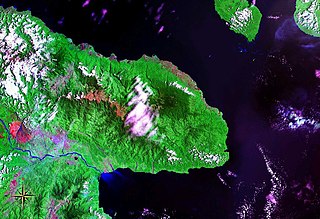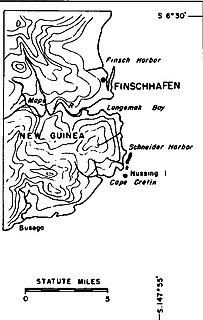
Morobe Province is a province on the northern coast of Papua New Guinea. The provincial capital and largest city is Lae. The province covers 33,705 km2, with a population of 674,810, and since the division of Southern Highlands Province in May 2012 it is the most populous province. It includes the Huon Peninsula, the Markham River, and delta, and coastal territories along the Huon Gulf. The province has nine administrative districts. At least 101 languages are spoken, including Kâte and Yabem language. English and Tok Pisin are common languages in the urban areas, and in some areas pidgin forms of German are mixed with the native language.
The Huon Gulf languages are Western Oceanic languages spoken primarily in Morobe Province of Papua New Guinea. They may form a group of the North New Guinea languages, perhaps within the Ngero–Vitiaz branch of that family.
The family of North Huon Gulf languages is a subgroup of the Huon Gulf languages of Papua New Guinea.

Huon Peninsula is a large rugged peninsula on the island of New Guinea in Morobe Province, eastern Papua New Guinea. It is named after French explorer Jean-Michel Huon de Kermadec. The peninsula is dominated by the steep Saruwaged and Finisterre and Cromwell Mountains. The nearest large town is the Morobe provincial capital Lae to the south, while settlements on the north coast include the former German town of Finschhafen, the district capital of Wasu, Malalamai and Saidor with its World War II era Saidor Airport.

Huon Gulf is a large gulf in eastern Papua New Guinea. It is bordered by Huon Peninsula in the north. Both are named after French explorer Jean-Michel Huon de Kermadec. Huon Gulf is a part of the Solomon Sea. Its northern boundary is marked by Cape Cretin, southern by Cape Longerue. The coast, which quickly increases in elevation from the beach, is bordered by the Rawlinson Range to the north and the Kuper Range to the west, which rises to about 600 m (2,000 ft). Lae, capital of the Morobe Province, is located on the northern coast of the gulf.
Numbami is an Austronesian language spoken by about 200 people with ties to a single village in Morobe Province, Papua New Guinea. It is spoken in Siboma village, Paiawa ward, Morobe Rural LLG.
Bukawa is an Austronesian language of Papua New Guinea.
Kala, also known as Kela, is an Austronesian language spoken by about 2200 people in several villages along the south coast of the Huon Gulf between Salamaua Peninsula and the Paiawa River, Morobe Province, Papua New Guinea.
Aribwatsa, also known as Lae or Lahe, is an extinct member of the Busu subgroup of Lower Markham languages in the area of Lae, Morobe Province, Papua New Guinea. Descendants of the Aribwatsa language community have mostly switched to the Bukawa language, which is spoken all along the north coast of the Huon Gulf and in several villages on the south coast.

Finschhafen is a town 80 kilometers (50 mi) east of Lae on the Huon Peninsula in Morobe Province of Papua New Guinea. The town is commonly misspelt as Finschafen or Finschaven. During World War II, the town was also referred to as Fitch Haven in the logs of some U.S. Navy men.
Sio is an Austronesian language spoken by about 3,500 people on the north coast of the Huon Peninsula in Morobe Province, Papua New Guinea. According to Harding and Clark (1994), Sio speakers lived in a single village on a small offshore island until the Pacific War, after which they established four villages on the nearby coast: Lambutina, Basakalo, Laelo, and Balambu. Nambariwa, another coastal village a few miles to the east, is also Sio-speaking.
Sio is a town on the north coast of Huon Peninsula, Papua New Guinea. It is located in Wasu Rural LLG, Morobe Province.
Kelanoa Harbour is a harbour on the north coast of Huon Peninsula, Papua New Guinea serving the town of Kelanoa. It is a large bay with an impenetrable reef and a small island.
Huon District is a district of the Morobe Province of Papua New Guinea. Its capital is Salamaua. The population of the district was 77,564 at the 2011 census.
Wasu is a town in Papua New Guinea. It is the capital of Tewae-Siassi District in Morobe Province, and is located on the Huon Peninsula. Wasu also serves as a gateway town for the Kabwum District, and is the seat of Wasu Rural LLG.
Wareo is a village on the Huon Peninsula, in Kotte Rural LLG, Morobe Province, Papua New Guinea. The village was liberated by the Australian Army during World War II in December 1943.
Jivevaneng is a town located on the Huon Peninsula, in Kotte Rural LLG, Morobe Province, Papua New Guinea.
Katika is a village on the Huon Peninsula, in Siki ward of Kotte Rural LLG, Morobe Province, Papua New Guinea.
Tami is an Austronesian language on the Tami Islands and in a few villages at the tip of the Huon Peninsula in Morobe Province, Papua New Guinea. It is not closely related to the other Huon Gulf languages, but like other North New Guinea languages in Morobe Province, its basic word order is SVO.
The Bitoi River is a river located in Morobe Province, Papua New Guinea. The river flows into the Huon Gulf south of Salamaua.



